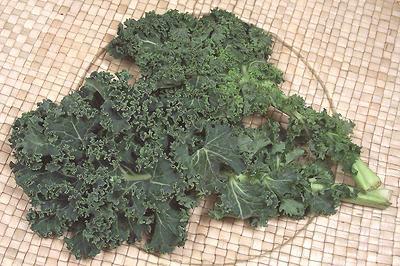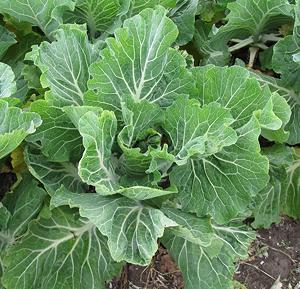
Curly Kale

Black / Tuscan Kale

Red / Red Russian Kale

Purple Kale

Dinosaur Kale

Portuguese Kale / Sukuma Wiki
Kale was well known in Europe before Roman times and until the Renaissance was the predominant type of cabbage in Europe. In fact it was the dominant green, particularly valued for being available well into winter. Genetically, Kale is closely related to Collard Greens.
For more on Cabbage Greens
Types of Kale
- Some important varieties are:Curly Kale:
This is the most common type of kale in North America and is found in practically every supermarket. Unfortunately, it's the most difficult variety to deal with in the kitchen.Black / Tuscan Kale:
This is the most popular kale in Italy. It is somewhat more tender than curly kale and it's more orderly leaves are easier to work with.Red Kale:
This frilly, red veined variety is less common than curly and black and, like black, is more tender and easier to manage than curly kale.Purple Kale
[Redbor Kale] This is a variety of Curly Kale that is a deep purple. One of the favorite uses for it is making Kale Chips.Dinosaur Kale:
This variety is found mainly in Farmer's Markets, and is much like Tuskan Kale, but less wrinkled.Sukuma Wiki:
Called "Collard Greens" in West Africa, this very important green is actually various varieties of broad leafed Kale, much more tender than our North American Collard Greens. The variety in the photo is Portuguese Kale. Photo borrowed from Latia Agribusiness Solutions Ltd under Fair Use.
Buying:
Curly Kale can be found in practically any supermarket in North America. Vast amounts are grown in California and shipped everywhere. Black and Red kale are best found in the Farmer's Markets which abound here in Southern California.Storage:
Loosely wrapped Kale will keep in the refrigerator for more than a week, but will gradually lose its vitamin content.Prep:
Wash just before use. Kale is float washed as you would spinach because the textures tend to hold grit and mud. The stems are usually discarded because they are very tough. Fold the two sides against each other and the stem will be easy to cut away.Cooking:
Kale, particularly curly kale, takes a fair amount of cooking, a reason why it often appears in soups. Other Kales may cook more quickly.Health & Nutrition:
Kale is considered the highest of all vegetables for nutrition per calorie. Kale is very high in Beta Carotene, Vitamin K, Vitamin C, Lutein, and Zeaxanthin, and fairly high in Potassium, Phosphorus, Magnesium and Calcium.When kale is chopped or chewed, enzymes produce Sulforaphane which is considered a potent anti-cancer substance, which also helps with diabetes and is antimicrobial. It is also thought to help inhibit heart inflammation.
Persons taking warfarin or some other anti-coagulants are cautioned against eating Kale due to its high vitamin K content, but newer anti-coagulants, including Rivaroxaban (Xarelto), Dabigatran (Pradaxa), and Apixaban (Eliquis) are compatible with Kale.